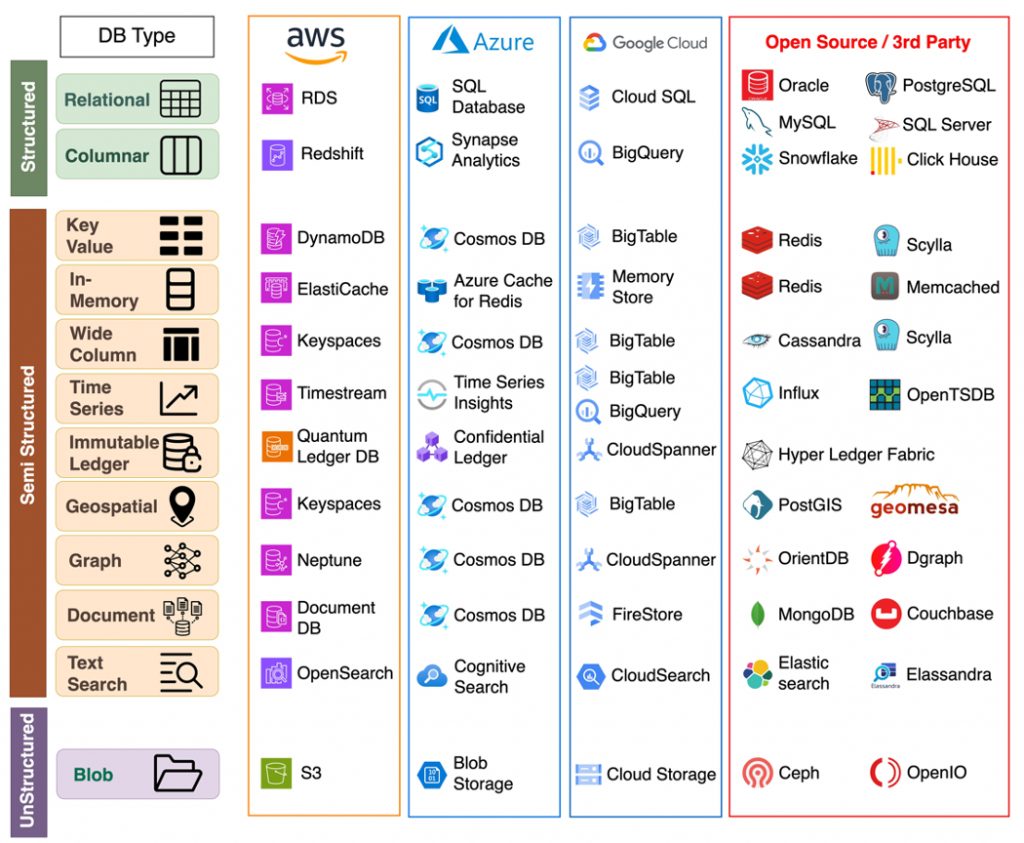We have heard many times that data is one of the most valuable (if not the most valuable) asset of companies. But there are many types of databases available and it is crucial to understand the differences in order to use the most appropriate one in each context. From traditional relational databases to graph databases, each has its own characteristics, strengths and preferred use cases.
Within databases, two main categories dominate the landscape: SQL databases and NoSQL databases. However, within NoSQL databases, there are also important subcategories. The essential differences lie in the way data is organized and managed, and this significantly impacts the performance and flexibility of each system. It is optimal to use each type of database for the purposes for which it is best suited.
SQL Databases
SQL databases, also known as relational databases, are based on the table, row and column model. They use the standard SQL query language to manipulate and query data. This structured approach provides a rigidity that ensures data integrity and makes it easy to perform complex query and transaction operations. SQL databases are ideal for applications that require consistency and clear relationships between data, such as inventory management and accounting systems. Examples of SQL databases include MySQL, PostgreSQL, Oracle and SQL Server.
NoSQL Databases
NoSQL, or Not Only SQL, is a term that encompasses a variety of databases that do not follow the traditional relational model. Within NoSQL databases, there are two main subcategories: structured and semi/unstructured.
Structured NoSQL Databases
Structured NoSQL databases offer a flexible alternative to relational databases by allowing more dynamic data models. They are usually also classified as semi-structured. Unlike SQL tables, they use structures such as family columns, wide columns or key-value to store data. This flexibility makes them especially suitable for applications that handle large volumes of distributed data, such as big data analytics systems and scalable web applications. For example Cassandra and HBase.
Semi / Unstructured NoSQL Databases
Semi-structured and unstructured NoSQL databases go a step further by allowing data management without a predefined fixed schema. This means that they can handle variable or unstructured data, such as JSON documents, XML or even videos in the unstructured ones, without requiring a rigid tabular structure. They are ideal for applications that need to adapt quickly to changes in data structure, such as content management systems and text analytics applications. Examples are MongoDB or Couchbase.

Let’s take a look at an overview of the most relevant database types and their different applications.
Structured
Relational Databases
Relational databases have been the mainstay of data management for decades. They use a tabular structure that organizes data into rows and columns, with defined relationships between them. They are ideal for applications that require complex and consistent transactions, such as inventory management systems, reservation systems and accounting systems.
Columnar Databases
Unlike relational databases, columnar databases store data in columns rather than rows, allowing more efficient processing for analytical and aggregation queries. They are excellent for business intelligence and data analytics applications, where fast response times and high performance on complex queries are needed.
Semi Structured
Key-Value Databases
These are usually simple databases, where data is stored in a simple key-value format. In them, each piece of data is associated with a unique key. They are suitable for applications that require quick access to individualized data, such as managing user sessions in web applications and storing application configurations.
In-Memory Databases
These databases store data in main memory (RAM) instead of on disk, providing ultra-fast access times. They are ideal for applications that require extremely high performance and instant response times, such as e-commerce systems and real-time gaming applications. It is worth mentioning in this section some databases that are of the columnar type, highly oriented to data analytics.
Wide Column Databases
Also known as wide column databases, these are optimized for storing and querying large volumes of structured and semi-structured data. They are especially useful for big data analytics applications, such as network monitoring and social network analytics.
Time Series Databases
Designed to handle data that is generated sequentially over time, such as sensor data, event logs and performance metrics. They are essential for real-time monitoring applications, financial forecasting and system performance analysis.
Immutable Ledger Databases
These databases are optimized to maintain an immutable and transparent record of transactions, making them ideal for blockchain accounting, asset management and smart contract applications.
Geospatial Databases
Designed to store and query data related to geographic location, such as maps, addresses and GPS coordinates. They are essential for logistics, navigation, geomarketing and location analytics applications.
Graph Databases
Graph databases model data as nodes and relationships, allowing complex queries of relationships between entities. They are essential for social network applications, network analysis, personalized recommendations and fraud detection.
Document Databases
These databases are designed to store, retrieve and manage semi-structured and unstructured data, such as JSON, XML and BSON documents. They are ideal for content management applications, product catalogs and knowledge management systems.
Unstructured
BLOB (Binary Large Objects) Databases
Used to store large binary objects, such as images, videos and audio files. They are essential for media management applications, file storage and multimedia content management systems.

Databases are the cornerstone of any modern enterprise application, which makes choosing the right database for each application crucial to ensure optimal performance and efficient scalability.
Making the right use of data and the technologies around it is critical for companies to make informed decisions that drive success and innovation in their operations.